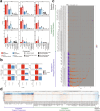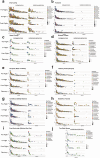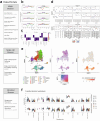The Space Omics and Medical Atlas (SOMA) and international astronaut biobank
- PMID: 38862028
- PMCID: PMC11357981
- DOI: 10.1038/s41586-024-07639-y
The Space Omics and Medical Atlas (SOMA) and international astronaut biobank
Abstract
Spaceflight induces molecular, cellular and physiological shifts in astronauts and poses myriad biomedical challenges to the human body, which are becoming increasingly relevant as more humans venture into space1-6. Yet current frameworks for aerospace medicine are nascent and lag far behind advancements in precision medicine on Earth, underscoring the need for rapid development of space medicine databases, tools and protocols. Here we present the Space Omics and Medical Atlas (SOMA), an integrated data and sample repository for clinical, cellular and multi-omic research profiles from a diverse range of missions, including the NASA Twins Study7, JAXA CFE study8,9, SpaceX Inspiration4 crew10-12, Axiom and Polaris. The SOMA resource represents a more than tenfold increase in publicly available human space omics data, with matched samples available from the Cornell Aerospace Medicine Biobank. The Atlas includes extensive molecular and physiological profiles encompassing genomics, epigenomics, transcriptomics, proteomics, metabolomics and microbiome datasets, which reveal some consistent features across missions, including cytokine shifts, telomere elongation and gene expression changes, as well as mission-specific molecular responses and links to orthologous, tissue-specific mouse datasets. Leveraging the datasets, tools and resources in SOMA can help to accelerate precision aerospace medicine, bringing needed health monitoring, risk mitigation and countermeasure data for upcoming lunar, Mars and exploration-class missions.
© 2024. The Author(s).
Conflict of interest statement
B.T.T. is compensated for consulting with Seed Health and Enzymetrics Biosciences on microbiome study design and holds an ownership stake in the former. K.L.B. receives research funding from Servier and Bristol Myers Squibb, serves on the medical advisory board of GoodCell. SC Employee and is a shareholder at NanoString Technologies. K.B., J.M., A. Boddicker, J.Z., B.L., A.A., S.K. and S.L. are employees of and have a financial interest in Element Biosciences. E.E.A. is a consultant for Thorne HealthTech. A.S.G., L.W., P.T., Q.Y., J.C., R.B., A. Siddiqui and D.H. are employees of and have a financial interest in Seer Inc. and Prognomiq Inc. C. Meydan is compensated by Thorne HealthTech. C.E.M. is co-founder of Cosmica Biosciences. D.C.L. and I.M. receive research grant support/funding from Atossa Inc. R.G. is on the scientific advisory board of Elysium Health, is an advisor to Gore Range Capital and is also an informal advisor to BelleTorus Corporation, but has no financial ties to BelleTorus at this time. C.M.S., J.C.S. and M.A. Schmidt hold shares in Sovaris Holdings LLC. J. Krumsiek holds equity in Chymia LLC, intellectual property in PsyProtix and is co-founder of iollo. M.Y. is the founder and president of CanTraCer Biosciences Inc. The GC COI list is available at
Figures















References
-
- Bushnell, D. M. & Moses, R. W. Commercial space in the age of ‘new space’, reusable rockets and the ongoing tech revolutions. NASAhttps://ntrs.nasa.gov/citations/20180008444 (2018).
MeSH terms
Substances
Grants and funding
LinkOut - more resources
Full Text Sources
Miscellaneous

